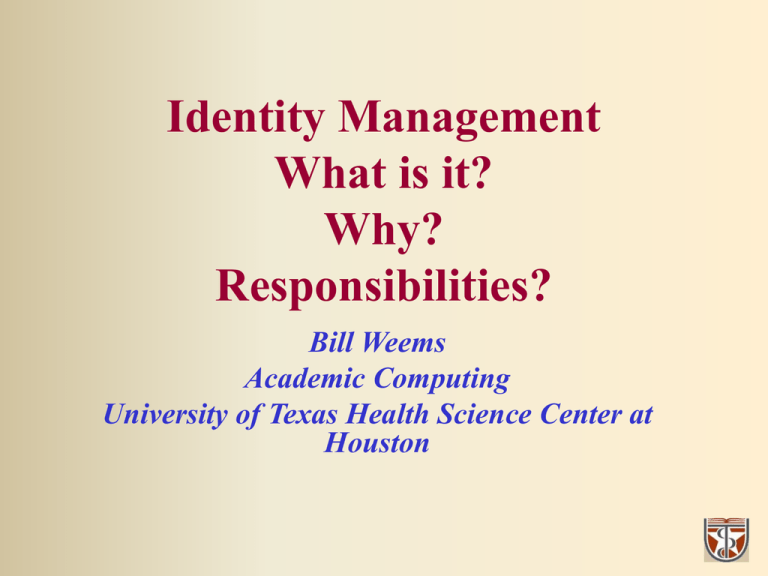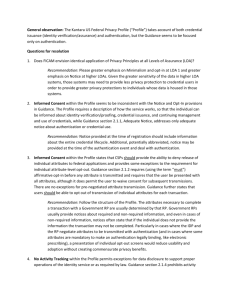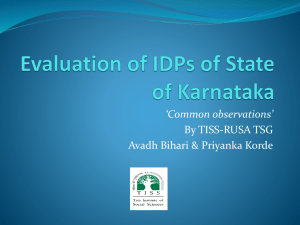An Identity Provider (IdP)
advertisement

Identity Management What is it? Why? Responsibilities? Bill Weems Academic Computing University of Texas Health Science Center at Houston Increasingly, people must easily and securely exchange information in cyberspace among "known" individuals and to securely access restricted resources they “know” can be trusted without having to struggle with numerous and onerous security processes. • How do you prove you are who you say you are? • How do you know that someone is legitimate in his or her dealings with you, and how do you get redress if things go wrong? • If your identity is stolen and used fraudulently, or personal records are altered without your knowledge or permission, how do you prove that it was not you? • It is difficult enough to verify someone's identity in the tangible world where forgery, impersonation and credit card fraud are everyday problems related to authentication. • Such problems take on a new dimension with the movement from face-to-face interaction, to the faceless interaction of cyberspace. Identity and Authentication by Simon Rogerson Ideally, individuals would each like a single digital credential that can be securely used to authenticate his or her identity anytime authentication of identity is required to secure any transaction. UTHSC-H: An Identity Provider (IdP) It is critical to recognize that the university functions as an identity provider (IdP) in that UTHSC-H provides individuals with digital credentials that consist of an identifier and an authenticator. As an IdP, the university assumes specific responsibilities and liabilities. Ideally, a digital credential must • positively identify a person, • positively identify the certifying authority i.e. the identity provider (IdP), • be presentable only by the person it authenticates, • be tamper proof, and • be accepted by all systems. Issuing a Digital Credential • Individual appears before an Identity Provider (IdP) which accepts the responsibility to – positively determine and catalog a person's uniquely identifying physical characteristics (e.g. picture, two fingerprints, DNA sample), – assign a unique, everlasting digital identifier to each person identified, – issue each identified person a digital credential that can only be used by that person to authenticate his or her identity, – maintain a defined affiliation with each individual whereby the validity of the digital credential is renewed at specified intervals. Identity Vetting & Credentialing Permanent Identity Database Identity Provider (IdP) uth.tmc.edu Assigns Everlasting Identifier Identifier Permanently Bound IdP Obtains Physical Characteristics Person Issues Digital Credential Person Only Activation Digital Credential Identity Vetting & Credentialing PKI Digital ID & Strong Two Factor Authentication Permanent Identity Database Identity Provider (IdP) uth.tmc.edu Assigns Everlasting Identifier Identifier Permanently Bound IdP Obtains Physical Characteristics Person Issues Digital Credential Person Only Activation Digital Credential Identity Vetting & Credentialing UTHSC-H Two Factor Authentication Permanent Identity Database Identity Provider (IdP) uth.tmc.edu Assigns Everlasting Identifier IdP Obtains Physical Characteristics Issues Digital Credential ? ? Identifier Permanently Bound Person Person Only Activation Digital Credential Identity Vetting & Credentialing UTHSC-H Username/Password Authentication Permanent Identity Database Identity Provider (IdP) uth.tmc.edu Assigns Everlasting Identifier IdP Obtains Physical Characteristics ? Issues Digital Credential ??????? Identifier Permanently Bound Person Person Only Digital Credential Activation Using Network Username Password Two Categories of Identity • Physical Identity – Body Identity - Authentication – Facial picture, – Fingerprints – DNA sample • Identity Attributes – Authorization Attributes – – – – – – – Common name, Address, Institutional affiliations - e.g. faculty, student, staff, contractor. Specific group memberships Birth date City of Birth Etc. Critical Identity Issues • Is a person positively identified? • Is person’s digital credential valid? • Is person currently affiliated with the university? – i.e. does UTHSC-H accept responsibility for this person’s Identity? • Is person’s authorization attributes valid – i.e. can they be “trusted”? – Are a person’s authorizations for specific applications appropriate? Identity Provider Liability Internal & External Services • Institution provides IdP services only for internal uses. – UTHSC-H personnel (LRAAs) responsible for identity vetting & credentialing – subject to audit. – Contracts with external organizations to provide vetting for their personnel having affiliations with UTHSC-H – defined as UTHSC-H Guests • Contract likely not auditable. • Institution provides IdP services to relying parties – e.g. U.T. System Federation members. – IdP services to relying parties should not be provided for “Guests”. Identity & Authentication Attributes • Identity Vetting – Basic Trust Level – Medium Trust Level – High Trust Level • Credential Strength – Two-factor PKI Biometric Token – Two-factor PKI Password Token – One-factor Network Username/Password UTHSC-H Strategic Authentication Goals • Two authentication mechanisms. – Single university ID (UID) and password. – Digital ID (DID) • Digital ID can be used to set password for UTHSC-H user ID – No one but “owner” ever knows UID password. – When password of UID is “aged” say every 90 days, user can use DID to reset the password. User never has to contact help desk; thus, freeing help desk to do other tasks! Policy and procedures associated with identifying, credentialing and authenticating employees, students and residents are reasonably appropriate at the university. However, another group of individuals such as contractors, research collaborators and others having legitimate, professional affiliations with the university do not have digital credentials issued by identity providers having relying partying agreements with UTHSC-H. Currently, the university accepts the legal responsibility of identifying these individuals, designated as guests, and issuing them digital credentials which they can use to authenticate their university certified identity to others. Individuals in this group are designated as “guests”. Because of the extremely varied circumstances associated with how “guest” affiliations arise and terminate, it is difficult to determine the current status of “guest” affiliations and associated levels of “trust”. To ensure that appropriate assurance levels can be asserted by UTHSC-H as an identity provider, special policies exist for identity proofing and credentialing of persons sponsored by individual university personnel. One such policy is the requirement that individuals being considered for an extension of their guest status for an additional year must have their identity formally re-vetted by the university, and their sole control of their digital credentials re-affirmed. It has been requested that this policy be reviewed. UTHSC-H requires individuals requesting an extension of their “Guest” status have their physically identity annually revetted and sign a statement attesting they: • are affiliated with the university as described by their sponsor, • have maintained and will maintain sole control of their digital credentials, • will immediately notify UTHSC-H if such control is comprised or if they are no longer affiliated with the university, and • their contact information, as presented, is correct. Individuals wanting to extend their “Guest” status and having a UTHSC-H digital ID/token can digitally sign a reaffirmation stating they • are affiliated with the university as described by their sponsor, • have maintained and will maintain sole control of their digital credentials, • will immediately notify UTHSC-H if such control is comprised or if they are no longer affiliated with the university, and • assert their contact information, as presented, is correct. Inter-institutional Identity Reconciliation • Problem: – Multiple identity providers (IdPs) in a Federation. – Individuals with multiple digital credentials issued by different IdPs. • Example: – Jane Doe is provisioned into Application A with UTMDACC credentials. – Moves to BCM & obtains new credentials. – How does application A handle this change of identity?




